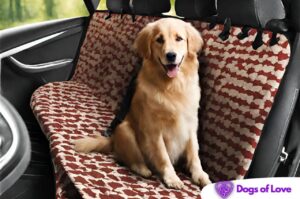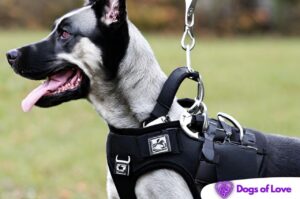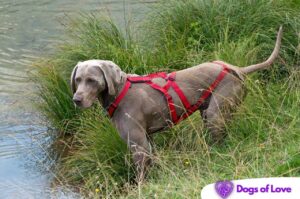In dog accessories, the harness is a valuable tool, offering pet owners various benefits, including control, safety, and comfort.
However, within the realm of harnesses, there is a distinction between those designed to enhance a dog’s mobility and those considered restrictive.
A restrictive dog harness is a type that, while serving some practical purposes, can limit a dog’s natural range of motion, potentially causing discomfort and even physical strain.
In this exploration, we will explore the concept of a restrictive dog harness, its potential advantages and disadvantages, and the situations in which it may or may not be appropriate for your four-legged friend.

How does a restrictive dog harness differ from other types of dog harnesses?
A restrictive dog harness distinguishes itself from other dog harness types through its specific design and function.
It is characterized by a harness structure that generally rests across a dog’s shoulders, with some designs even incorporating an additional strap placed beneath the axilla of both front legs and extending across the dog’s back, creating pressure points over the scapula.
This configuration is engineered to discourage or control certain dog behaviors, like pulling on a leash or jumping.
While these harnesses may serve specific training needs, they should be chosen thoughtfully, as they can impose constraints on a dog’s movements and, if used incorrectly or excessively, may lead to discomfort or potential health concerns for the canine companion.
Are there any specific breeds or sizes of dogs that are more suited to using a restrictive harness?
The suitability of a restrictive harness can be influenced by a dog’s breed, size, and individual behavior.
While restrictive harnesses can be used for various breeds and sizes, they are often more effective for dogs that are particularly strong, energetic, or prone to pulling on a leash.
Breeds like Huskies, German Shepherds, or large working breeds may benefit from a restrictive harness during training to manage their considerable strength.
Smaller breeds with delicate necks or those prone to tracheal issues may also benefit from a restrictive harness that redistributes the pressure away from their neck and throat.
However, it’s essential to choose the right size and fit for your dog, regardless of their breed, to ensure their comfort and safety when using a restrictive harness.
Additionally, individual temperament and behavior should be considered; a professional dog trainer can offer guidance on whether a restrictive harness is suitable for your specific dog.
What are the potential disadvantages or risks of using a restrictive dog harness?
Using a restrictive dog harness, while having its training benefits, comes with potential disadvantages and risks.
These harnesses can restrict a dog’s natural range of motion, potentially leading to discomfort and even musculoskeletal issues, especially if not fitted correctly or used excessively.
The pressure applied to the shoulder area can hinder a dog’s ability to move freely and comfortably, impacting their gait and posture.
Overuse of a restrictive harness may also cause chafing or skin irritation.
Moreover, some dogs may become anxious or stressed when wearing these harnesses, as they may find them uncomfortable or restrictive.
It’s crucial to be cautious when using such harnesses, ensuring that they are used sparingly and with proper fitting to minimize these potential risks and prioritize your dog’s well-being.
Are certain situations or events where using a restrictive dog harness might be more beneficial or appropriate?
There are specific situations and events where using a restrictive dog harness can be more beneficial or appropriate.
Training sessions, mainly when teaching a dog not to pull on a leash or to maintain good behavior in high-distraction environments, are prime examples of where a restrictive harness may serve as a valuable tool.
For dog owners who require robust control during activities like agility training, obedience competitions, or when navigating crowded public spaces, a restrictive harness can offer additional control and security.
In cases where a dog has a medical condition, such as tracheal problems or neck sensitivity, a restrictive harness that avoids pressure on the neck and throat may be the safer choice.
However, it’s crucial to use these harnesses judiciously and ensure proper fit to minimize discomfort or potential risks while considering alternative training methods that prioritize positive reinforcement and a dog’s natural movement when appropriate.
Are there specific signs to look for that might indicate a dog is uncomfortable in a restrictive harness?
There are specific signs to watch for that may indicate a dog is uncomfortable in a restrictive harness.
These signs include restlessness and fidgeting, attempts to scratch or chew the harness, excessive panting, or vocalizing, such as whining or whimpering.
Dogs may also exhibit reluctance to move or walk, and their body language can show signs of stress, such as ears pinned back, a lowered tail, or avoiding eye contact.
Some dogs might attempt to escape the harness, showing discomfort through resistance to putting it on or removal.
If you notice any signs of discomfort or distress, it’s essential to assess the fit of the harness, make sure it’s not too tight or restrictive, and consider alternative harness options.
A dog’s comfort and well-being should always be a top priority when using any harness, restrictive or otherwise.
What are the Tips for Making Your Dog Comfortable in Their Restrictive Dog Harness?
Ensuring your dog’s comfort in a restrictive harness is essential for a positive experience.
To make your dog comfortable, select the right size and type of harness that suits your dog’s specific needs.
Proper fitting is crucial; ensure it is snug but not tight, allowing a couple of fingers to fit between the harness and your dog’s skin.
Gradually introduce your dog to the harness by allowing them to sniff and explore it before putting it on.
Use positive reinforcement, such as treats and praise, to create a positive association with the harness.
Begin with short periods of wear, gradually increasing the time your dog spends in the harness to help them acclimate.
Regularly check for discomfort or chafing and make any necessary adjustments.
By following these tips and maintaining patience, you can help your dog feel comfortable and secure in their restrictive harness, ensuring a safe and enjoyable experience for both of you.
In conclusion
A restrictive dog harness is a unique type of harness designed with the primary goal of controlling or modifying certain dog behaviors, such as pulling or jumping.
While these harnesses can serve valuable training purposes, they come with certain limitations and potential risks that dog owners should be aware of.
The key distinction of a restrictive harness lies in its design. It is characterized by a harness structure that generally rests across a dog’s shoulders, with some designs even incorporating an additional strap placed beneath the axilla of both front legs and extending across the dog’s back, creating pressure points over the scapula.
It’s essential to select and use these harnesses carefully, ensuring they are appropriately sized and used for their intended training objectives.
Additionally, monitoring your dog for signs of discomfort or stress is crucial.
Ultimately, choosing a restrictive harness should be guided by a dog’s individual needs and behavior, with their comfort and well-being as top priorities, while always considering alternative training methods that prioritize positive reinforcement and a dog’s natural mobility when appropriate.








